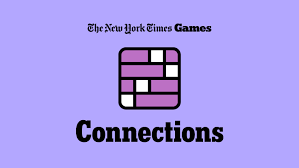Described as a game where you find words that share a common thread, Connections is a New York Times game featured along with the viral Wordle game, The Crossword, and other NYT brain teasers. Through the pandemic you heard people say, “Did you get the Wordle?” or you saw your mom send her scores to her friends. So is Connections the new craze? Its popularity grows every day simply from the phrase, “Did you do the Connections today?” So what’s the big deal? Why are we suddenly finding ourselves invested in our scores and ability to play the game?
As a student and a teen, at first when I heard about the Connections, I laughed. I laughed at the fact that I saw a friend, a 17-year-old using the NYT app to play a game. I associated doing the NYT games with older adults, with the idea that they wake up and have to do their crossword puzzles in the newspaper. The idea of a 17-year-old playing doing this did not ever cross my mind. As I watched my friend play, I found myself wanting to play myself. The next day I played and have every day since. The more that I played the more I heard, “Did you do the Connections today?” I’ve seen countless classmates struggle through pairing the words into their groups, working together to figure it out. Since when do students, kids play NTY games? It’s not only students, it’s adults, parents sending their kids their scores for the daily Connections.
So why? Why do we play this game? One student shared that her AP Chem teacher introduced it to her. “I think people like it because it gets competitive and it’s also more fun than the Wordle because it’s harder, so it’s more fulfilling when you complete it.” The fact that people play it to be challenged and use it to fuel their competitive side may not only be a common pattern, but also scientific. In general, people need challenges as the National Library of Medicine reportes, “…the concept of challenge is a critically important element for well-being and optimal functioning.” Essentially this means that we as humans need and crave challenge. But how does a daily 10 minute game with no greater impact fulfill our need for challenge? Connections is a risk-free way for us to think and problem-solve in new ways that might eventually help us figure out the word groups.
Sure it’s a simple game that takes most people no longer than five minutes, but there’s somthing to consider when noticing the “craze” surrounding it. It’s not only Connections, there are several other games that people rave about. The challenge that these games provide is just enough to satisfy society’s need for challenge and a risk-free way to compete. A lot of these “crazes” or phenomena can be understood by looking at the science and psychology of the desire to play them. Then again, it’s just a simple game.






